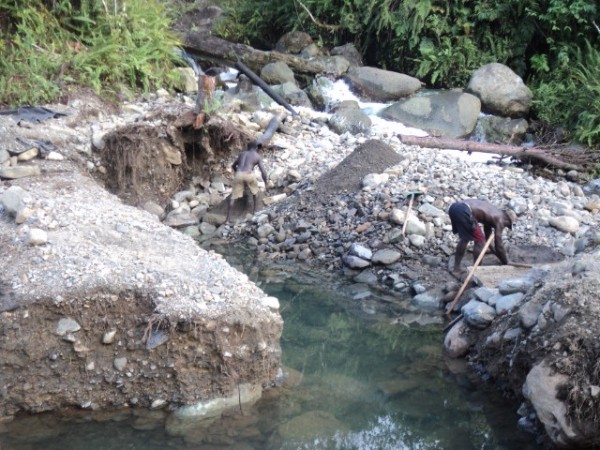Pressemitteilungen 2013
19.08.2013
ESBC press release 20130819
The European Shareholders of Bougainville Copper (ESBC) back and support the Autonomous Bougainville Government (ABG) and its President John Momis. All their efforts made in the ongoing struggle for positive development on Bougainville deserve high respect. The ABG is the only legitimate representative of Bougainvilleans.
No individual or groups of individuals can pretend to have a platform of authority. They just represent themselves and the ABG represents the collective will of all Bougainvilleans.
The so-called "leaked" document from 2011 proves and underlines the ABG's democratic approach to the matter. The meeting in question gathered most of the stakeholders concerned by a re-opening of the Panguna mine. PNG exposed today's interpretation of the ABG's politics is false and misleading. It shows once more again the huge lack of democratic sense in and around Bougainville.
09.11.2013
ESBC press release 29131109
The Mercury Threat
Silent suicide -
Illegal artisanal gold miners risk the life of innocent Bougainvilleans!
The island of Bougainville is rich in precious assets: Especially gold is in the focus of indigenous people who want to earn some money by small scale mining.
Unfortunately they are not aware that their new “business” is highly dangerous and can even be mortal! On the nearby Solomon Islands (SI) Transparency Solomon Islands is actually urging the government to investigate claims that mercury is being used at the gold mine on Guadalcanal as Radio New Zealand International reports.
As in Solomon Islands the use of mercury is the customary way to separate gold from the rocks in Bougainville as well. This gold is then sold to scrupulous dealers who don’t care that Bougainville’s environment may be damaged for years. They also don’t even care if Bougainvilleans may die from severe intoxication.

Such criminal individuals, some of them are so called “former combatants”, are trying to undermine the ABG’s honourable struggle to re-implement modern environmental caring mining on Bougainville. Only a few huge mining companies such as Rio Tinto or BHP Billiton are able to provide such sophisticated high-end technology. Quite obviously these mean money makers in the background try to protect their dirty business at any price. Brief: They are simply thefts who steal from mother earth. And they don’t pay taxes either.
Read here a scientific report on the use of mercury in small scale mining and find out all about the mercury related fatal dangers:
Small scale mining – one of the worst pollution problems

Introduction
Many gold deposits are too low in gold content nowadays to use efficiently the panning technique. Therefore, mercury amalgamation is used to extract gold from rocky ores after crushing them in mills. This method is often referred to as artisanal gold mining.
It is estimated that the world production of artisanal gold is 225 tons. One million persons are employed of which 40% are women. Only 20% of the artisanal gold produced is sold through official channels. For example: In Latin America, over 1 million artisanal gold miners produce between 115 and 190 tons of gold, emitting over 200 tons of mercury annually. Between 2 and 8 miners produce 1 kg of gold annually. Mercury is an effective, simple and very inexpensive reagent to extract gold (1kg of mercury costs 1 g of gold). The Netherlands and Germany are the main suppliers of mercury. It is estimated that the environment is polluted with more than 1 kg of mercury for every kg of gold produced.
Toxicity of mercury
Mercury (element with the symbol Hg) is a liquid metal at room temperature, which is or has been used in thermometers, electrical switches or relays and as amalgam material in dental restoration. One striking chemical property of mercury is the ability to dissolve many other metals such as gold or silver to form amalgams. Mercury is found on earth either as native metal (rare) or in cinnabar (HgS) and recovered from the latter by heating.
Mercury and most of its transformation products in human and the environment are extremely toxic and can cause severe chronic diseases such as kidney failure, arthritis, loss of memory, depression, hallucinations, suicidal tendency, respiratory failure and even death.
A serious industrial disaster was the dumping of mercury compounds into Minamata bay, Japan. It is estimated that over 3,000 people suffered various deformities, severe mercury poisoning symptoms or death from what became known as Minamata disease.
Exposure
Artisanal gold mining releases mercury which contributes significantly to the aspheric mercury deposition. When mercury is used in the amalgamation process with gold the heating of the amalgam releases high amount of mercury which are taken-up by inhalation. The minors and their families and children are immediately exposed to the noxious vapors. Mercury, which enters into the water body, is rapidly transformed to the even more toxic methylmercury. Methylmercury can bio-accumulate into sediment organisms of streams, fish and the food chain.
Population living downstream of the mercury pollution source are continuously exposed to the toxic transformation products of mercury although they are not involved in artisanal gold mining.
Conclusion
Artisanal gold mining with mercury for small scale mining poses a high risk not only to the miners and their families but also causes long-term adverse effects to the environment and at different levels of the food chain. Not only people living along the contaminated side but also those living considerably far away from the mercury source are continuously exposed to toxic levels of mercury and its transformation products.